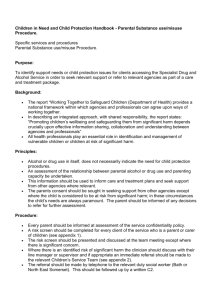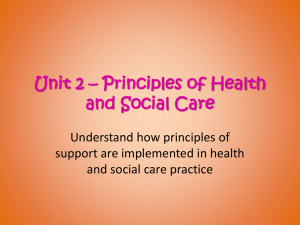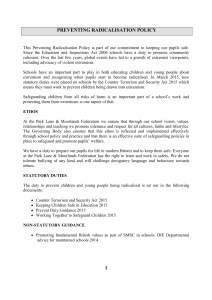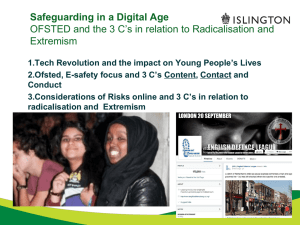LA advice on travel to conflict zones Nov 15
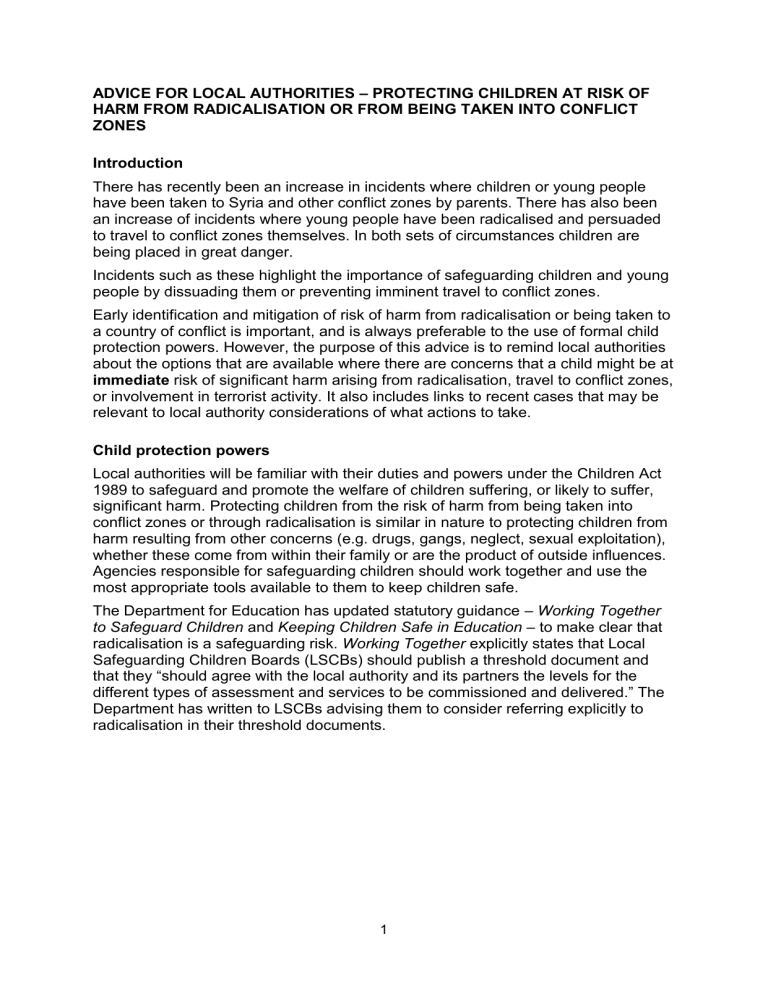
ADVICE FOR LOCAL AUTHORITIES
– PROTECTING CHILDREN AT RISK OF
HARM FROM RADICALISATION OR FROM BEING TAKEN INTO CONFLICT
ZONES
Introduction
There has recently been an increase in incidents where children or young people have been taken to Syria and other conflict zones by parents. There has also been an increase of incidents where young people have been radicalised and persuaded to travel to conflict zones themselves. In both sets of circumstances children are being placed in great danger.
Incidents such as these highlight the importance of safeguarding children and young people by dissuading them or preventing imminent travel to conflict zones.
Early identification and mitigation of risk of harm from radicalisation or being taken to a country of conflict is important, and is always preferable to the use of formal child protection powers. However, the purpose of this advice is to remind local authorities about the options that are available where there are concerns that a child might be at immediate risk of significant harm arising from radicalisation, travel to conflict zones, or involvement in terrorist activity. It also includes links to recent cases that may be relevant to local authority considerations of what actions to take.
Child protection powers
Local authorities will be familiar with their duties and powers under the Children Act
1989 to safeguard and promote the welfare of children suffering, or likely to suffer, significant harm. Protecting children from the risk of harm from being taken into conflict zones or through radicalisation is similar in nature to protecting children from harm resulting from other concerns (e.g. drugs, gangs, neglect, sexual exploitation), whether these come from within their family or are the product of outside influences.
Agencies responsible for safeguarding children should work together and use the most appropriate tools available to them to keep children safe.
The Department for Education has updated statutory guidance – Working Together to Safeguard Children and Keeping Children Safe in Education – to make clear that radicalisation is a safeguarding risk. Working Together explicitly states that Local
Safeguarding Children Boards (LSCBs) should publish a threshold document and that they “should agree with the local authority and its partners the levels for the different types of assessment and services to be commissioned and delivered.” The
Department has written to LSCBs advising them to consider referring explicitly to radicalisation in their threshold documents.
1
In cases where there are concerns around children being radicalised or being taken into conflict zones, local authorities should work with their families at the earliest opportunity. Where cases are referred to c hildren’s social care, there are a range of statutory interventions available to practitioners, for example:
section 17 of the Children Act 1989: to provide a range of services appropriate to support a child in need;
section 47 of the Children Act 1989: carrying out investigations where there is reasonable cause to suspect a child is suffering or likely to suffer significant harm to decide what, if any, action should be taken to safeguard and promote the welfare of the child;
the Channel programme: where children or adults thought to be at risk from radicalisation should be referred for assessment and possible support.
Referral to Channel may be in conjunction with other actions under the
Children Act 1989. Guidance on Channel is available at https://www.gov.uk/government/publications/channel-guidance
The local authority should work with the police to share information about the individual child and their family and network of close friends/associates as appropriate. Information should be sought at the earliest opportunity from all relevant agencies that may know about the family or child in question.
In some cases where agencies are aware of imminent travel plans and that children are likely to be taken into conflict zones, or where there is a significant risk of harm through radicalisation, it may be necessary to take swift action through the courts to protect children.
In a small number of cases, the courts have made orders under the Children Act
1989 to protect children who are suffering, or are likely to suffer, significant harm as a result of radicalisation occurring within their families or of travel to Syria. In those cases the effect of the orders is to protect (and if necessary remove) children from their parents. An application can be made to the court for an interim care order under the Children Act 1989. Where immediate action is necessary to protect a child an emergency protection order can be sought, with or without notice to the parents.
Inherent jurisdiction of the court
In other cases, action has been taken under the inherent jurisdiction of the High
Court in relation to radicalisation and/or travel to a conflict zone. An application can be made to the High Court without notice to the parents, and even when the child has already been taken out of the country as inherent jurisdiction orders are recognised by many other countries. Wardship is one part of the High Court’s inherent jurisdiction and offers immediate protection. Under the inherent jurisdiction the courts have very broad powers to protect children, including imposing conditions on others both within and outside a child’s family. The conditions that may be imposed include:
2
confiscation of travel documents;
prohibition from leaving the country or making travel arrangements;
asking the UK Border Agency not to issue new passports;
prohibiting individuals from association with a child; and
restrictions on movement within the UK- electronic tagging and curfew of the parents has been used in one case.
Section 100 of the Children Act 1989 limits the ability of local authorities to make applications under the inherent jurisdiction. It makes clear that proceedings under the inherent jurisdiction can only be commenced where local authorities cannot use powers under the Children Act 1989 to achieve their goal. In cases involving local authorities, the court can only grant leave if it is satisfied that the child is likely to suffer significant harm if the court does not exercise its inherent jurisdiction. The police can also apply directly under the inherent jurisdiction but should do so in discussion with the local authority.
When considering court applications the local authority should ensure that they contact the police at the earliest opportunity and consult with them at a senior level.
The police may have additional information and be able to advise on conditions that should be considered as part of the application.
In all cases, the child’s welfare will be the court’s paramount consideration. The exercise of the inherent jurisdiction is discretionary, so the court may refuse to exercise its powers where it considers it inappropriate to do so.
In some cases, action has been initiated under the Children Act 1989, but subsequently taken under the inherent jurisdiction where it was judged that it was in the best interests of the child to remain with their parents.
The President of the Family Division has recently issued guidance for judges and advocates involved in radicalisation cases (including travel to Syria) in the family courts: https://www.judiciary.gov.uk/wp-content/uploads/2015/10/pfd-guidanceradicalisation-cases.pdf
The content of the guidance might be reviewed from time to time, and it is therefore recommended that the website is checked regularly for any updates.
The annex to this document gives examples of recent cases which may help inform local authority considerations of whether to take specific actions under the Children Act 1989 or via the inherent jurisdiction of the High Court.
Information sharing
Statutory guidance, Working Together to Safeguard Children
( https://www.gov.uk/government/uploads/system/uploads/attachment_data/file/4195
95/Working_Together_to_Safeguard_Children.pdf
) makes clear the importance of effective information sharing, and all organisations should have arrangements in place setting out the processes and the principles for sharing information with one another. General advice on information sharing is set out in https://www.gov.uk/government/publications/safeguarding-practitioners-informationsharing-advice.
3
Statutory guidance on the Prevent duty guidance highlights the importance of information sharing agreements at local level to ensure the rights of individuals are fully protected. The general principles of necessity, proportionality, consent, and power to share apply as well as the Data Protection Act and the Common Law Duty of Confidentiality (see https://www.gov.uk/government/publications/prevent-dutyguidance ).
The Prevent duty guidance also explains that there may be circumstances where specified authorities, in the course of Prevent-related work, identify someone who may already be engaged in illegal terrorist-related activity. People suspected of being involved in such activity must be referred to the police.
Where a child referred to children's social care is vulnerable to radicalisation, a
Channel referral should also be considered. In those cases where a Channel referral is not appropriate and other safeguarding interventions are pursued, the police should always be informed.
In cases which require comprehensive consequence management, for example where a child has returned from a conflict zone such as Syria, it is recommended that a member of the senior leadership team is appointed as strategic lead to ensure that all aspects of a case, including information sharing and multi-agency work, are being conducted effectively.
The police will have arrangements in place for sharing sensitive intelligence with safeguarding partners when appropriate so that they can fulfil their statutory responsibilities. In some circumstances information may be shared in confidential multi-agency meetings on condition that it is not shared further. In such circumstances the police will always provide clear and explicit handling instructions.
The use of sensitive intelligence in legal proceedings
In a very small number of cases involving radicalisation, including where there is an intention to travel to a conflict zone, the police may be in possession of relevant sensitive intelligence. The police have guidance for the assessment, management and, if relevant, sharing of such intelligence with the courts in order to allow the presiding judge to make an informed decision. Where civil proceedings are a factor within safeguarding/risk management plans, guidance is available to local authorities, partners and their legal representatives in ‘Radicalisation Cases in the
Family Court’ ( https://www.judiciary.gov.uk/wp-content/uploads/2015/10/pfdguidance-radicalisation-cases.pdf
)
Department for Education
13 November 2015
4
Examples of relevant cases
The London Borough of Tower Hamlets and M & Others [2015] EWHC 869 (Fam) https://www.judiciary.gov.uk/judgments/between-the-london-borough-of-towerhamlets-and-m-and-others/
In these cases, the local authority was of the view that the families of the children involved were unlikely to adequately protect the children by preventing them from leaving the UK. The court was satisfied that each of the children “was at risk […] of significant harm in the sense contemplated by section 31(ii) [sic.] of the Children Act
1989.” [paragraph 3] While noting that “the type of harm I have been asked to evaluate is a different facet of vulnerability for children than that which the courts have had to deal with in the past” [paragraph 57], the judgement concluded “What, however, is clear is that the conventional safeguarding principles will still afford the best protection. Once again, this court finds it necessary to reiterate that only open dialogue, appropriate sharing of information, mutual respect for the differing roles involved and inter agency cooperation is going to provide the kind of protection that I am satisfied that the children subject to these applications truly require.” [paragraph
58]
Brighton & Hove City Council v Mother, Father and Y (A Minor) [2015] EWHC 2098
(Fam) and [2015] EWHC 2099 (Fam) http://www.familylawweek.co.uk/site.aspx?i=ed145920
The court considered that due to Y’s personal history (both brothers and a friend had been killed fighting in Syria and his uncle had been held at Guantanamo Bay), he was “extremely vulnerable… to radicalisation.” [paragraph 10]
Given the age of Y, the local authority considered that it was more appropriate for Y to be made a ward of court than to rely upon the limited scope of care orders in relation to 16 year olds. In addition, it appears there was no intention to remove Y from the care of his mother. The court concluded that the use of the wardship jurisdict ion is “ideally fitted to the very specific nature of the risk contemplated.”
[paragraph 13]
In addition, the court concluded that “when balancing the competing rights and interests required under the Human Rights Act, to my mind the balance falls down clearly in protecting this young man, ultimately from himself.” [paragraph 13]
5
In the matter of M (Children) [2015] EWHC 1433 (Fam) https://www.judiciary.gov.uk/judgments/in-the-matter-of-m-children-wardshipjurisdiction-and-use-of-super-injunctions/
The court’s inherent jurisdiction was used to facilitate the return of a family of four children (who were believed to be travelling with their parents on to Syria) from
Turkey via Moldova. This included an order that the children be made wards of the court and that the parents surrender the passports of the children to social workers who had specifically travelled out to assess the children. The application for the order was made ex partes and a reporting restriction was made in relation to the case so as not to alert the parents to the fact of the order being made (for fear of flight by the parents).
In the matter of X and Y [2015] EWHC 2265 (Fam) https://www.judiciary.gov.uk/wpcontent/uploads/2015/08/re-x-and-y-no2.pdf
Despite interim care orders having previously been made in respect of the two families following attempts by the parents to remove the children to Syria, the court used innovative measures (the use of GPS tagging), as well as measures often used in cases of international abduction (removal of passports, etc.) under the inherent jurisdiction to return the children to the care of their parents.
In these joined cases, the primary focus was on the risk of significant harm to the children should they travel to Syria, rather than the question of whether the children had been radicalised.
The London Borough of Tower Hamlets and B https://www.judiciary.gov.uk/judgments/london-borough-of-tower-hamlets-v-b/
B, a sixteen year-old girl, had already been made a ward of court on application from the local authority having attempted to travel to Syria. B was made the subject of a
Child in Need plan, predicated on the local author ity’s evaluation of the parents’ positive potential to safeguard her themselves.
Following a search of the family’s home, radicalising material was found on devices belonging to B, her siblings and her parents. The local authority sought the removal of B and her siblings from their parents.
In this case, the court concluded that B “has been subjected to serious emotional harm, and, at the very least, continues to be at risk of such in her parent’s [sic] care.
I can see no way in which her psychological, emotional and intellectual integrity can be protected by her remaining in this household.” [paragraph 28]
The court compared the harm suffered by B to the effects of sexual abuse: “The violation contemplated here is not to the body but it is to the mind. It is every bit as insidious, and I do not say that lightly. It involves harm of similar magnitude and complexion.” [paragraph 29]
6

